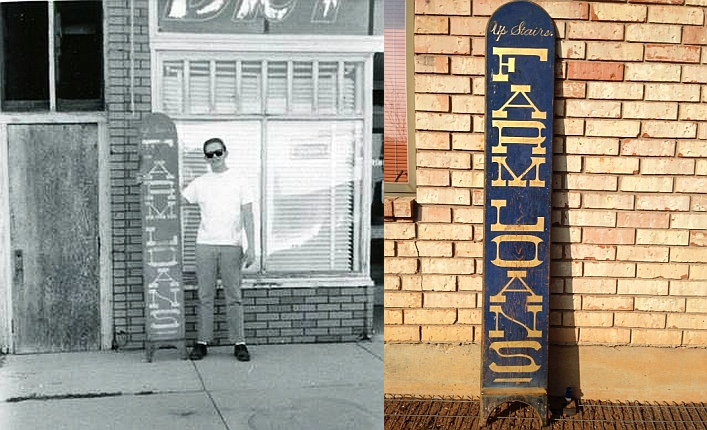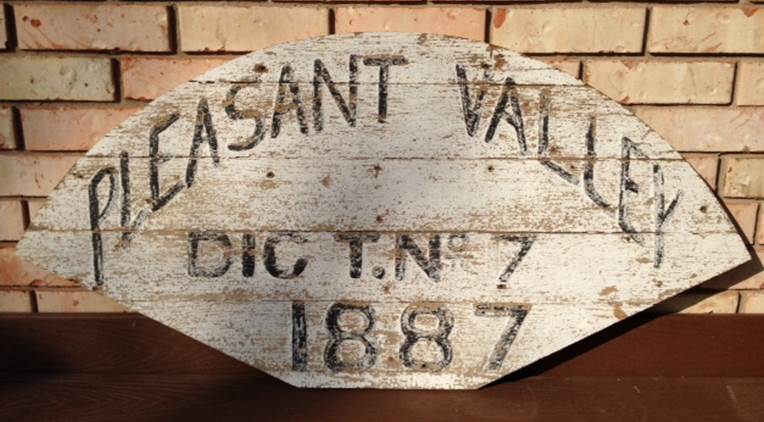
Coordinator's Note - About 50 years ago one-time Akron resident Rollie Schafer Jr and his father Rollie Schafer Sr had the prescience to look for and recover some historically significant signs in and around Akron Colo. In so doing they took various measures to preserve the signs. Rollie Jr will donate the signs and a packet of envelopes to History Colorado, the successor to the Colorado State Historical Society. Rollie Jr submitted a detailed write-up about his and his father's service to the history of Washington County; it is presented below. - Washco Coordinator
In 1967, when I was twenty-five years old, I recovered two historic signs from the attic of the building adjoining my dad’s drugstore (Schafer Drugs) in Akron at 93 Main Street to the north. The adjacent building south was a Red & White grocery store run by Fred W. Hawkinson Sr in the early 1950s.
I first saw the two signs in the building's attic in 1957 when my friend and Akron High School classmate, Wendell Brinkmann, invited me to enter the attic. Wendell's parents ran a dry goods store on the first floor of the two-story building, which they rented. Prior to the Brinkmann Dry Goods store, the building held a butcher shop.
In 1967, the building was abandoned and in an advanced state of disrepair. Its back door was unlocked and the back stairway was falling in. In the image below, the front entrance to the front stairs to the second story to my right is boarded up. My dad, Rollie Schafer, Sr. got me access to the building, although I do not remember who owned the property in 1967. It may have been owned by Mr. Tom Harpham who also owned the adjacent building north containing my dad's drugstore. My father is long since dead, so I cannot consult him on this part of the story. In 2010, the last time I visited Akron, both the drugstore and the adjoining building next door were closed and the old dry goods building had deteriorated considerably.

The sign was signed "O'LAUGHLIN" at the bottom in the painted bar below the terminal “S”. The sign’s background is dark blue with fine sand mixed into the blue paint to enhance the contrast with the gold-painted letters. The sign’s edge is beveled at 45° and is also painted gold, which nicely frames the sign. Obviously, the sign’s creator, Mr. O’Laughlin, was an artist.
The sign was from the Farmers and Traders Bank (see below for more information on this bank) that opened on the second floor of the pictured building in 1887. I have not researched the bank’s history, but I believe that the bank closed around 1890—certainly by 1893 when the Panic of 1893 closed thousands of U.S. banks (the panic was marked by the collapse of railroad overbuilding and shaky railroad financing which set off a series of bank failures).
The two signs that I recovered in 1967 had apparently been stored in the attic of the building when the bank closed. Both signs are in magnificent shape, as they were exposed to the elements for only three or four years. The paint was applied professionally and still appears fresh.
The second sign I recovered in 1967 is also a bank sign from the Farmers and Traders Bank. It is double-sided and was meant to be mounted so as to project from the building’s front facade. I suspect that the sign was mounted above the doorway to the stairway to the second story of the building which housed the bank. The “MONEY to LOAN” sign’s dimensions are 5-inches high by 45-1/4-inches long.

By 1967, a feedlot had been established immediately north of the school. The vacant school building was being used to store cattle-feed pellets and other items that needed protection from the weather. Again, my dad got permission from the feedlot owner to remove the sign from the site. The property may have been owned by the Hall Grain Company at 101 West Railroad Avenue, which operated a feed store and grain elevators in Akron. My dad and I removed the sign, which was nailed to the building. The sign is shown below.

The sign’s dimensions are 52-inches wide by 25-1/2-inches tall. The sign is constructed of inch-thick, tongue-in-groove wood and was shaped exactly as depicted. I affixed ½-inch thick plywood to the back of the sign to stabilize the tongue-in-groove joints. The edges of the plywood and approximately 1/16-inch to 1/8-inch of the sign’s perimeter were sawn into the shape shown here. The original sign had a 7/8-inch-thick band of wood around the perimeter of the sign projecting about a half-inch from the sign’s surface but in 1967, most of the band of wood around the sign was missing or broken and could not be salvaged. I intended to replace the wooden band around the sign but never followed through, because the top margin would have to be steamed and bent to the curved shape.
I have not researched the history of the Pleasant Valley School, but one of its last teachers, Mr. Cecil Foree, taught there in the 1930s and 1940s (U.S, Census of Akron, Washington County, Colorado). Mr. Foree later served as Washington County Clerk into the 1950s through the 1970s.
[The Pleasant Valley school district was first organized as district 3 but was reorganized in 1887 into district 7. It was located some four miles west of Akron on what is now US Highway 34. It was consolidated with Akron School System in the 1950s.] - Ed
I contacted History Colorado, the successor to the Colorado State Historical Society and offered the three signs to them. They agreed to accept the donation, which I’ll make next June when we return to our mountain cabin at Raymond, Colorado, which is fifteen miles west of Lyons nest to Middle St. Vrain Creek.
Rollie sent some additional research on this bank (Sept 5th 2016) - Ed
I searched Coloradohistoricnewspapers.org and found advertisements for the Farmers and Traders Bank in the Akron Weekly Pioneer Press in April through December 1888 but none in the period of January 1, 1886-December 31, 1887. I also found advertisements for “E.E. Edmonds, Attorney, Akron, Colorado, Office Over Farmers and Traders Bank” in the Pioneer Press in 1888. The president of the Farmers and Traders Bank was J.E. Phillips and the cashier was H.A. Lewis, as shown on several of the advertisements. An August 31, 1888 insurance advertisement lists the insurers as “Phillips & Lewis,” but does not refer to the Farmers and Traders Bank.
Another bank, the Washington County Bank, was also advertised in 1888. An October 19, 1888 newsbreak in the Pioneer Press says that, “Mr. J.E. Phillips, late president of the Farmers and Traders bank, has purchased the Washington County bank of C.W. Smith. Mr. Phillips will be pleased to meet his many friends at the new place of business. Mr. Phillips has shown to the people of this section during his two years of business, that he is a sound financier and a safe conservative business man, in whom they base confidence. See his advertisement.”

The Washington County Bank advertisement in the same issue and a subsequent December 28, 1888 issue shows “J.E. Phillips, President.” However, the Washington County Bank is not advertised in subsequent issues from January 1, 1889 through December 31, 1893. I’m sure the Panic (depression) of 1893 put all or most of Akron’s two or three banks out of business. A newsbreak in the Pioneer Press of April 15, 1892 lists “J.E. Phillips, Clarinda, Iowa” under the heading, “New Subscribers.” I’m guessing that Mr. Phillips closed the Washington County Bank in 1889-1892 then moved to Clarinda, which is located in far southwest Iowa. J.E. Phillips was a reasonably young man in 1888. A June 15, 1888 newsbreak in the Pioneer Press says that “Last Friday it was noticed that face of President Phillips, of the Farmers and Traders Bank, wore a pleased expression. Reason for this was learned to be that a bouncing young banker had arrived that morning. Mother and baby doing well.
Washington County also experienced dry years in 1889-1890. Akron pioneer, Millard Fillmore Vance, reported:
“There was a great exodus from this region [Washington County] in 1889 and 1890 and again in 1893-95.
Many homes and farms were given up and deserted.”
- Colorado Magazine 1931, Vol 8, pp 173-179
Both the Washington County Bank and the Farmers and Traders Bank were heavily into farm loans.